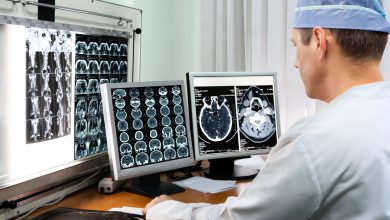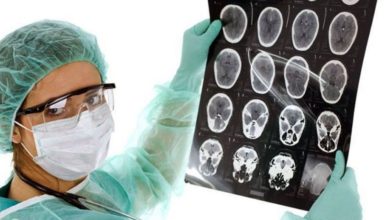How to identify a brain tumor
The content of the article
How to determine a brain tumor, that is, a neoplasm, which is a disease with a characteristic cancerous lesion of the membrane, nerve endings, vessels of the endocrine system, and the skull.
Each such pathology is manifested by a numerous number of symptoms, some of which are characteristic of other ailments.
Causes of symptoms
How to accurately and timely detect a brain tumor? This problem can be solved by relying on modern diagnostic methods that will identify the sources causing the symptoms. It could be:
- A tumor or inflammatory processes associated with its growth and penetration into other parts of the brain, which have the effect of pressing on its elements and preventing their normal functioning;
- Swelling of the tumor and the occurrence of inflammatory processes around the tumor;
- The manifestation of similar symptoms of primary brain cancer or metastatic, the most commonly observed type of tumor.
The appearance of symptoms depends on which area of the brain the disease begins to grow; sometimes they do not appear at all for a very long time inside the skull.
Manifestation and development of tumors
How to identify the first signs of this terrible disease. The reason to contact a medical center is the appearance of the following symptoms:
- Headaches, mainly accompanying the development of a tumor inside the skull. Sometimes, besides this symptom, there is no other evidence of the disease. How to recognize a brain tumor if the nature of the pain is manifested by internal pressure bursting the skull, with a pressing sensation in the eye area? As a rule, in the presence of a tumor, such localization of pain is not observed, except in cases of focal neoplasms. Initially, the headache occurs at certain intervals and disappears with the use of painkillers. Over time, the pain becomes more severe and resistant to the effects of drugs aimed at reducing it. The nature of the pain can acquire varying degrees of strength during the day. Most often, patients experience severe pain in the morning, since the natural outflow of blood during sleep is hampered by the presence of a tumor. How to identify a brain tumor and distinguish it from ordinary poisoning? It will allow the use of a simple technique - changing the position of the human body. The vertical position of a waking person is accompanied by an outflow of cerebrospinal fluid and blood from the skull, which is accompanied by a decrease in intracranial pressure in general and headaches decrease;
- Symptoms of brain tumor disorders include nausea and vomiting. These symptoms are not related to food intake; they may appear early in the day, before meals. Nausea and vomiting characteristic of poisoning are usually accompanied by upset stool and abdominal pain, which is impossible with cerebral spasms.
Focal tumors
Focal growths may also be accompanied by nausea and vomiting, which can be alleviated to some extent by changing head position. Such manifestations are accompanied by vegetative responses from the body: unexpected sweating, respiratory rhythm disturbances, hiccups, changes in skin color, and loss of consciousness.
- Increased pressure inside the skull may be accompanied by dizziness. Neoplasms inside the brain compress the vessels of the circulatory system of the head. The symptom does not have any specific features, but this sign should not be overlooked in the presence of other symptoms;
- Pressure of tumor inflammation on the congestive optic disc. In most cases it causes swelling in the eye area and blurred vision. In medicine, this pathology is considered an obligatory sign of tumors in the brain. The process of visual acuity impairment progresses and cannot be corrected with optical lenses;
- Constant intracranial pressure in most cases causes mental disorders in patients. Primary signs of impaired concentration or memory cause emotional instability. Progression of tumor growth can provoke aggression and inappropriate behavior;
- A type of epileptic seizures of the generalized category, which accompany patients in most cases of cancer. They are unpredictable and occur when the patient is absolutely calm and well-being. This is a very serious symptom that requires mandatory medical monitoring.
The appearance of a tumor in the brain is not always indicated by certain symptoms, and their manifestation during the course of the disease has its own characteristics. It all depends on the location of the tumors inside the skull.
Establishing a diagnosis of a brain tumor
If persistent health problems appear, it is imperative to consult a doctor, who will prescribe a number of diagnostic procedures to check the head for the presence of oncological manifestations.
Identified abnormalities in the patient’s nervous system provide grounds for clarifying the diagnosis. For this purpose, modern diagnostic methods are used. Since X-ray readings provide insufficient information, computer techniques are used for a more accurate diagnosis of a tumor, one of them is CT - computed tomography or another version of MRI - magnetic resonance imaging.
With their help, it is possible to determine the exact location of the tumor and its size. How to check if there is a brain tumor? Currently, computer methods are used.
- The type of tumor is determined by examining part of the affected tissue using a microscope. The method in medicine is called biopsy;
- Cerebral fluid is subjected to microscopic examination if the development of a malignant tumor is suspected. Cerebral fluid is obtained using a lumbar puncture. This procedure is used only if there is no increase in intracranial pressure. Otherwise, a serious complication called herniation may occur. The consequence may be disruption of the respiratory process, heart contractions, and a sharp change in blood pressure;
- A biopsy is performed during surgery to remove the entire tumor. To identify oncology located in remote areas of the brain that are difficult to reach with a surgeon’s instrument, modern equipment is used to scan the required area. With the help of the latest devices, the surgeon is able to monitor the manipulations of the needle designed to select the affected tissue.
Existing methods help doctors both recognize a brain tumor and prescribe the correct treatment in the early stages of the disease.
Treatment methods for brain tumors
Studies performed in the diagnostic department make it possible to prescribe individual treatment to the patient, since the treatment regimen is determined by several factors: age, general condition of the patient, the size of the tumor formation, its type and location in the skull. As a rule, treatment involves the participation of specialists in various fields: oncologist, neurologist, neurosurgeon, radiologist, physiotherapist and rehabilitation specialist.
There are newer techniques used to treat patients diagnosed with a brain tumor.
Surgical method
Surgery is the most commonly used treatment procedure. This method is used to remove the tumor and identify it.
If the tumor is difficult to access, surgeons perform a biopsy to obtain a portion of the tissue necessary to determine the type of tumor. Removing benign tumors often allows one to obtain satisfactory results and improve the patient’s condition. During surgery, the neurosurgeon tries to remove the entire growth.
Surgery is advisable for brain tumors, since in this case the surgeon has the opportunity to remove part of the healthy tissue, which will provide a greater guarantee against the recurrence of a harmful tumor.
However, in the case of brain surgery, the neurosurgeon's capabilities are greatly limited due to the characteristics of the tissues that are responsible for certain body functions.
At the present stage, the section of surgery has been replenished with new non-surgical methods for removing harmful formations. This is the so-called stereotactic (radiosurgery) method. This category includes gamma knives, cyber knives and proton beam surgery.
As a rule, before the upcoming surgical intervention, the patient undergoes conservative treatment, which consists of the following:
- undergoing an anti-inflammatory steroid course to reduce swelling in the area of the tumor;
- prophylactic administration of drugs that reduce the possibility of involuntary seizures during surgery;
- the use of a shunt method to reduce the patient’s hypertensive state by removing excess cerebral fluid.
After carrying out the necessary preliminary procedures, neurosurgeons use the optimal method for removing oncology.
Method of radiation therapy for brain tumors
Radiation therapy is a popular method of treating cancer. It is resorted to if surgical intervention is unacceptable.
This method is also used after surgical removal of a harmful formation. This is necessary to prevent relapse of the disease. The radiation method is used to locally remove the affected cells. In this case, only part of the brain is exposed to radiation, a certain dose calculated by the doctor individually, taking into account all factors.
Cancer chemotherapy method
In medicine, this method is classified as a systemic course of treatment. The effect is exerted on the patient’s entire body, that is, during the treatment process, both affected and healthy cells are affected.
One or more drugs are used for treatment. The entire course of treatment is selected by oncologists according to a specific scheme, taking into account all factors: age, concomitant diseases, degree of risk. The drugs are designed for oral and intravenous administration.
Stereotactic radiosurgery method
The method of stereotactic radiosurgery in medicine is considered a radiation method of surgery. When used, a cancerous tumor is exposed to a beam of radio rays, brought together to one point by moving the beam, which necessarily passes through the harmful formation, thereby destroying the tumor.
Modern computer developments make it possible to treat tumors in any area of the brain inaccessible to a scalpel with high precision.
Endoscopic treatment method
The method of endoscopic treatment of brain tumors involves penetration of the tumor through small incisions.
This process is carried out using special endoscopic devices. This technique achieves accurate access to the tumor lesion in the brain. In this case, there are no disturbances in the blood vessel system. .
Promising treatment methods cannot yet guarantee complete recovery of patients with cancer in the naked eye. Only certain types of tumors do not resume their development within five years after undergoing a course of treatment or surgery.
Please rate the article:





